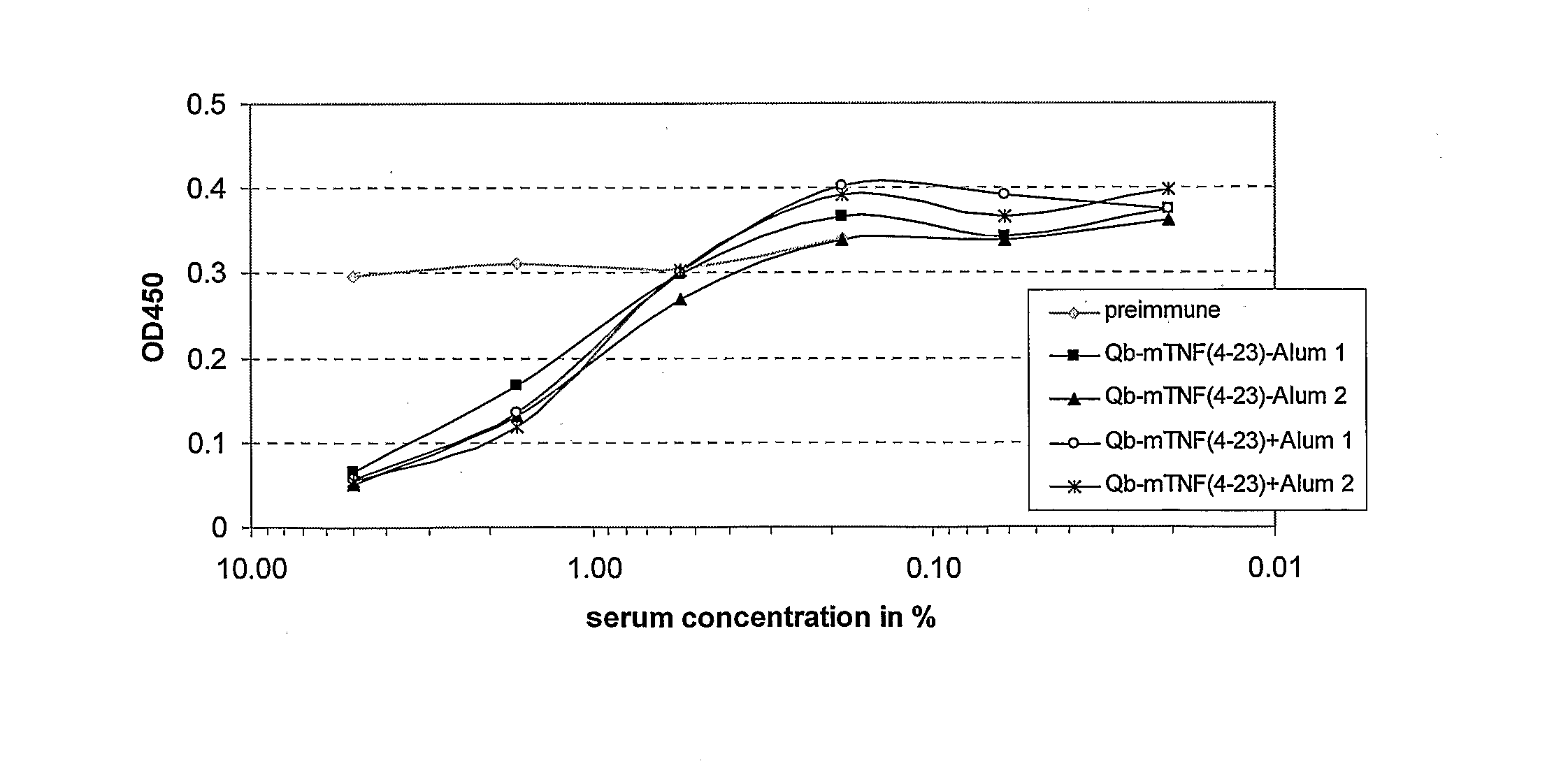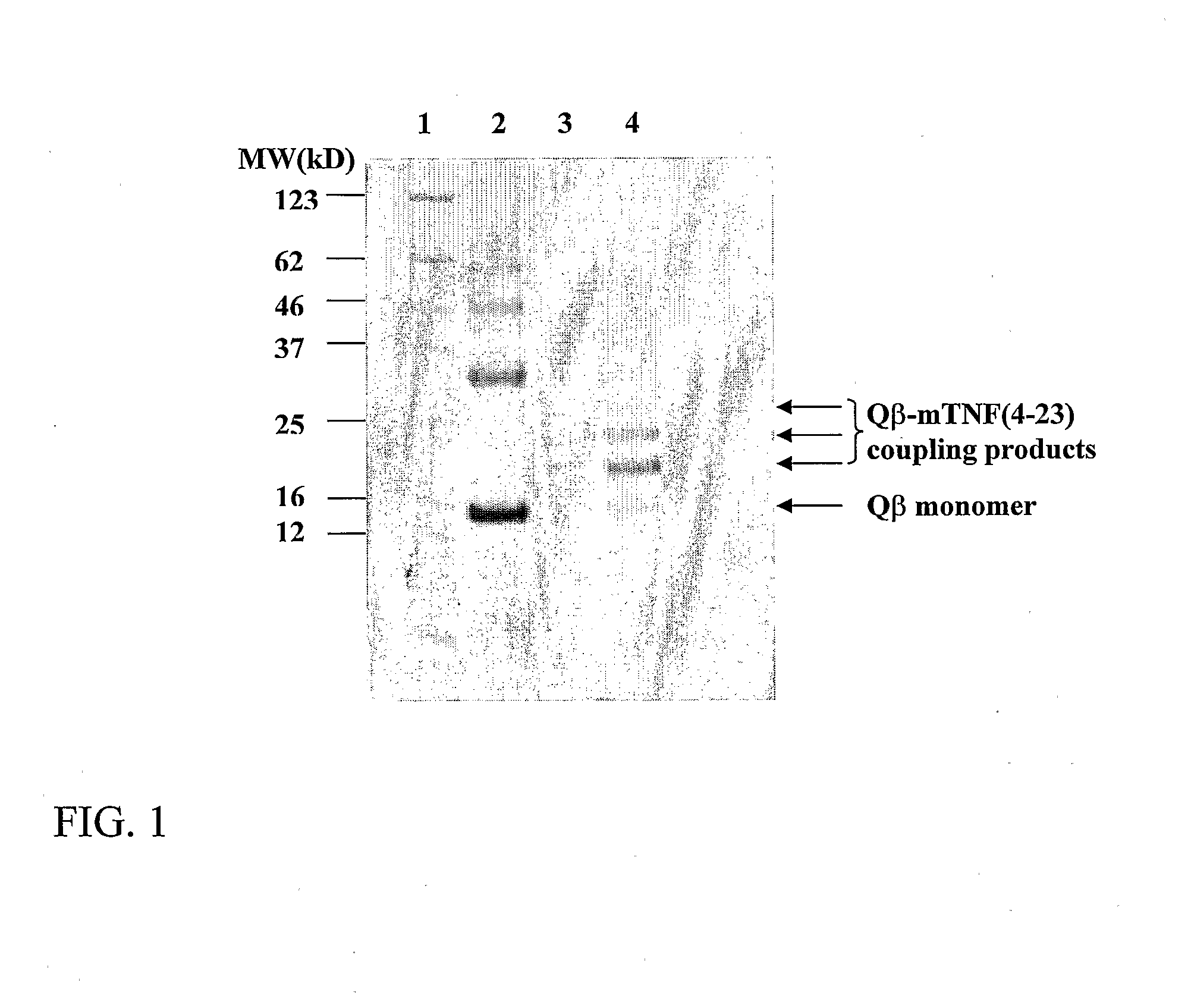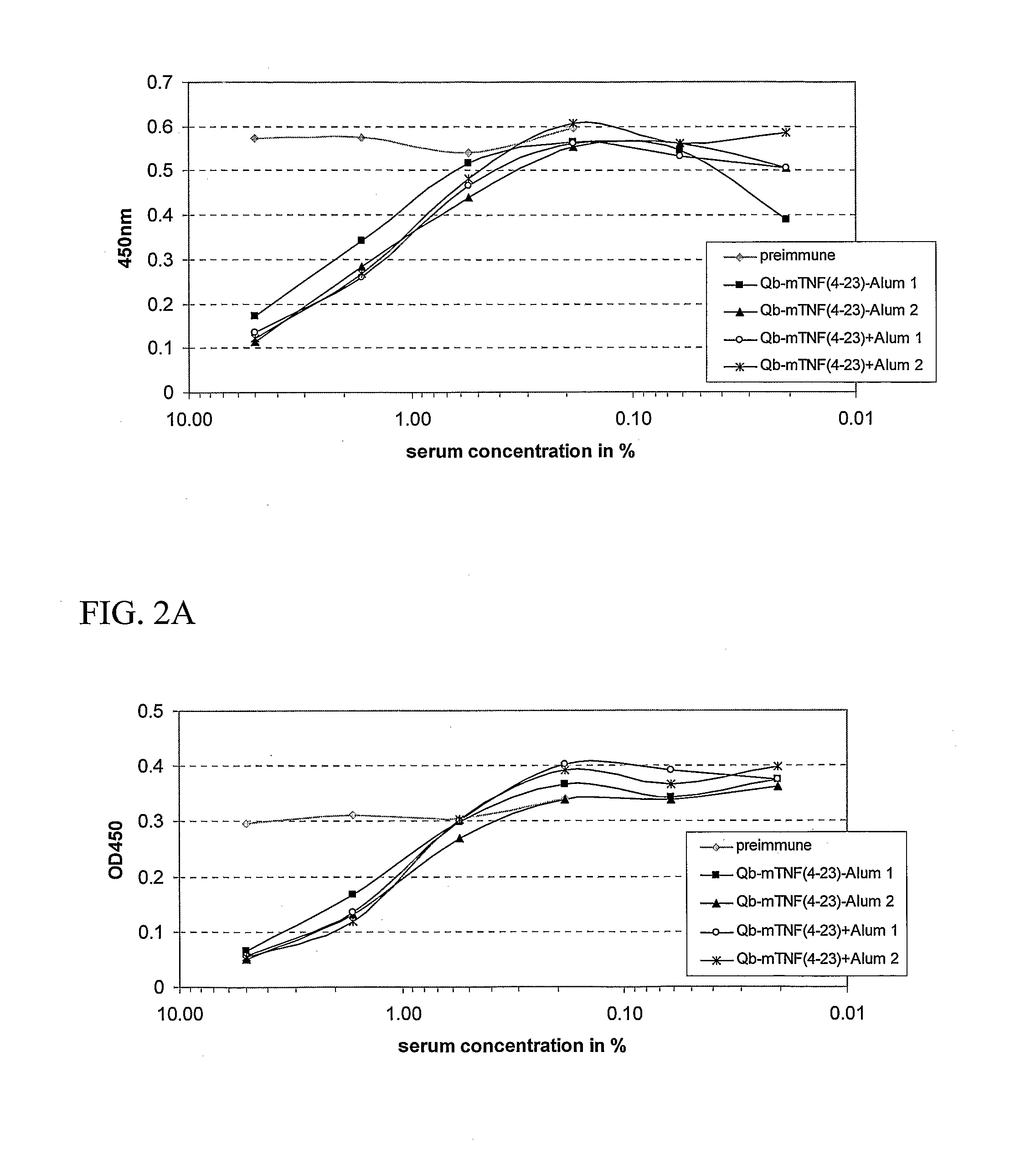Carrier Conjugates Of Tnf-Peptides
a carrier conjugate and peptide technology, applied in the field of molecular biology, virology, immunology and medicine, can solve the problems of inability of the immune system to produce antibodies against self-derived structures, the inability to induce antibody responses against self-antigens, and the inability to deliver self-antigens to carriers that can deliver t help, etc., to achieve enhanced antigen absorption and skin permeability. , the effect of increasing the permeability
- Summary
- Abstract
- Description
- Claims
- Application Information
AI Technical Summary
Benefits of technology
Problems solved by technology
Method used
Image
Examples
example 1
A. Coupling of Murine TNFα(4-23) Peptide to Qβ Capsid Protein
[0262] A solution of 3 ml of 3.06 mg / ml Qβ capsid protein in 20 mM HEPES, 150 mM NaCl pH 7.2 was reacted for 60 minutes at room temperature with 99.2 μl of a SMPH solution (65 mM in DMSO). The reaction solution was dialysed at 4° C. against two 3 l changes of 20 mM HEPES, 150 mM NaCl pH 7.2 for 4 hours and 14 hours, respectively. Sixty-nine μl of the derivatized and dialyzed Qβ solution was mixed with 265.5 μl 20 mM HEPES pH 7.2 and 7.5 μl of mTNFα. (4-23) peptide with the second attachment site (SEQ ID NO:29: CGGSSQNSSDKPVAHVVANHQVE) (23.6 mg / ml in DMSO) and incubated for 2 hours at 15° C. for chemical crosslinking. Uncoupled peptide was removed by 2×2 h dialysis at 4° C. against PBS. Coupled products were analysed on a 12% SDS-polyacrylamide gel under reducing conditions. The Coomassie stained gel is shown in FIG. 1. Several bands of increased molecular weight with respect to the Qβ capsid monomer are visible, clearly d...
example 2
A. Coupling of mTNFα(11-18) Peptide to Qβ Capsid Protein
[0267] A solution of 3.06 mg / ml Qβ capsid protein in 20 mM HEPES, 150 mM NaCl pH 7.2 is reacted for 60 minutes at room temperature with a 10 fold molar excess of SMPH (SMPH stock solution dissolved in DMSO). The reaction solution is dialysed at 4° C. against two 3 l changes of 20 mM HEPES pH 7.2 for 4 hours and 14 hours, respectively. The derivatized and dialyzed Qβ solution is mixed with 20 mM HEPES pH 7.2 and a 5 fold molar excess of mTNFα(11-18) peptide with the second attachment site (SEQ ID NO:2: CGGKPVAHVVA) and incubated for 2 hours at 16° C. for chemical crosslinking. Uncoupled peptide is removed by 2×2 h dialysis at 4° C. against PBS. In case of precipitation, lower excess of SMPH and / or peptide are used. Coupled products are separated on a 12% SDS-polyacrylamide gel under reducing conditions and stained with Coomassie to identify the cross-linking of the mTNFα peptide to the Qβ capsid.
B. Immunization of Mice with mT...
example 3
A. Coupling of mTNFα(9-20) Peptide to Qβ Capsid Protein
[0271] A solution of 3.06 mg / ml Qβ capsid protein in 20 mM HEPES, 150 mM NaCl pH 7.2 is reacted for 60 minutes at room temperature with a 10 fold molar excess of SMPH (SMPH stock solution dissolved in DMSO). The reaction solution is dialysed at 4° C. against two 3 l changes of 20 mM HEPES pH 7.2 for 4 hours and 14 hours, respectively. The derivatized and dialyzed Qβ solution is mixed with 20 nM HEPES pH 7.2 and a 5 fold molar excess of mTNFα(9-20) peptide with the second attachment site (SEQ ID NO:3: CGGSDKPVAHVVANHQ) and incubated for 2 hours at 16° C. for chemical crosslinking. Uncoupled peptide is removed by 2×2 h dialysis at 4° C. against PBS. In case of precipitation, lower excess of SMPH and / or peptide are used. Coupled products are separated on a 12% SDS-polyacrylamide gel under reducing conditions and stained with Coomassie to identify the cross-linking of the mTNFα peptide to the Qβ capsid.
B. Immunization of Mice with...
PUM
| Property | Measurement | Unit |
|---|---|---|
| Time | aaaaa | aaaaa |
Abstract
Description
Claims
Application Information
 Login to View More
Login to View More - R&D
- Intellectual Property
- Life Sciences
- Materials
- Tech Scout
- Unparalleled Data Quality
- Higher Quality Content
- 60% Fewer Hallucinations
Browse by: Latest US Patents, China's latest patents, Technical Efficacy Thesaurus, Application Domain, Technology Topic, Popular Technical Reports.
© 2025 PatSnap. All rights reserved.Legal|Privacy policy|Modern Slavery Act Transparency Statement|Sitemap|About US| Contact US: help@patsnap.com



